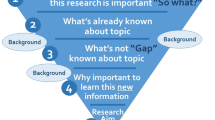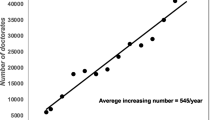Abstract
This article explores the emergence of knowledge from scientific discoveries and their effects on the structure of scientific communication. Network analysis is applied to understand this emergence institutionally as changes in the journals; semantically as changes in the codification of meaning in terms of words; and cognitively as the new knowledge becomes the emergent foundation of further developments. The discovery of fullerenes in 1985 is analyzed as the scientific discovery that triggered a process which led to research in nanotubes.
Article PDF
Similar content being viewed by others
Avoid common mistakes on your manuscript.
References
Amsterdamska, O., Leydesdorff, L. (1989). Citations: Indicators of significance? Scientometrics, 15: 449–471.
Braun, T., Schubert, A., Zsindely, S. (1997). Nanoscience and nanotechnology on the balance, Scientometrics, 38: 321–325.
Burt, R. S. (1982). Toward a Structural Theory of Action. Academic Press, New York, etc.
Callon, M., Law, J., Rip, A. (Eds) (1986). Mapping the Dynamics of Science and Technology. Macmillan, London.
Chen, C. (2006). CiteSpace II: Detecting and visualizing emerging trends and transient patterns in scientific literature, Journal of the American Society for Information Science and Technology, 57(3): 359–377.
Cobert, D. (2003). Single-wall nanotubes: a new option for conductive plastics and engineering polymers. Plastics, Additives & Compounding: January/February 2003.
Cozzens, S. (1985). Comparing the sciences: Citation context analysis of papers from Neuropharmacology and the Sociology of Science, Social Studies of Science, 15(1): 127–153.
Cozzens, S. E., Leydesdorff, L. (1993). Journal systems as macro-indicators of structural change in the sciences. In: A. F. J. van Raan, R. E. DDe Bruin, H. F. Moed, A. J. Nederhof, R. W. J. Tijssen (Eds), Science and Technology in a Policy Context. DSWO/Leiden University, Leiden, pp. 219–233.
Ebbesen, T. W., Ajayan, P. M. (1992), Large scale synthesis of carbon nanotubese. Nature, 368: 220–222.
Fujigaki, Y. (1998). Filling the gap between the discussion on science and scientist’s everyday’s activity: applying the autopoiesis system theory to scientific knowledge, Social Science Information 37(1): 5–22.
Garfield, E. (1973). Historiographs, librarianship, and the history of science. Essays of an Information Scientist, 2: 134–135.
Garfield, E. Pudovkin A. I., Istomin V. S. (2005). Algorithm citation linked histography-Mapping the literature of science, Proceedings of the American Society for Information Science and Technology, 38(1): 14–24.
Guo, T., Nikolaev, P., Rinzler, A., Tománek, D., Colber, D., Smalley, R. (1995). ’Self-assembly of tubular fullerenes, Journal of Physical Chemistry, 99: 10694–10697
He, C., Pao, M. L. (1986). A discipline-specific journal selection algorithm. Information Processing & Management, 22(5): 405–416.
Hesse, M. (1980). Revolutions and Reconstructions in the Philosophy of Science. Harvester Press, London.
Iijima, S. (2002). The carbon nanotube a product of nanotechnology. Aichi Voice 15; at: http://www2.aia.pref.aichi.jp/voice/no15/15_cutting_edge.html
Kamada, T., Kawai, S. (1989). An algorithm for drawing general undirected graphs. Information Processing Letters, 31(1): 7–15.
Kroto, H. (1987). The stability of the fullerenes C-24, C-28, C-32, C-36, C-50, C-60 and C-70. Nature, 329(6139): 529–531.
Leydesdorff, L. (1991). The static and dynamic analysis of network data using information theory. Social Networks, 13: 301–345.
Leydesdorff, L. (1995). The Challenge of Scientometrics: The Development, Measurement, and Self-Organization of Scientific Communications. DSWO Press/Leiden University, Leiden; at http://www.upublish.com/books/leydesdorff-sci.htm.
Leydesdorff, L. (2002). Some epistemological implications of semiosis in the social domain. Semiotics, Evolution, Energy, and Development (SEED) Journal, 2(3): 60–83.
Leydesdorff, L. (2007). Scientific communication and cognitive codification: social systems theory and the sociology of scientific knowledge, European Journal of Social Theory, 10(3), in print.
Leydesdorff, L., Cozzens, S. E. (1993). The delineations of specialities in terms of journals using the dynamic journal set of the SCI, Scientometrics, 26: 133–154.
Leydesdorff, L., Cozzens, S., Van den Besselaar, P. (1994). Tracking areas of strategic importance using scientometric journal mappings, Research Policy, 23: 217–229.
Leydesdorff, L., Hellsten, I. (2005). Metaphors and diaphors in science communication: Mapping the case of ’stem-cell research’. Science Communication, 27(1): 64–99.
Lux Research Report (2005) Nanotechnology gold rush yields crowded, entangled patents; at: http://www.luxresearchinc.com.
Meyer, M., Persson, O. (1998). Nanotechnology: interdisciplinarity, patterns of collaboration and differences in application, Scientometrics, 47: 195–205.
Salton, G., McGill M. J. (1983). Introduction to Modern Information Retrieval. Auckland, etc.: McGraw-Hill.
Schmoch, U. (1997). Indicators and the relations between science and technology. Scientometrics, 38(1): 103–116.
Schummer, J. (2004). Multidisciplinarity, interdisciplinarity, and patterns of research collaboration in nanoscience and nanotechnology, Scientometrics, 59: 425–465.
Teil, G., Latour, B. (1995), The Hume machine. Can association networks do more than formal rules? Stanford Electronic Humanities Review 4(2), athttp://www.stanford.edu/group/SHR/4-2/text/teillatour.html.
Author information
Authors and Affiliations
Corresponding author
Rights and permissions
Open Access This is an open access article distributed under the terms of the Creative Commons Attribution Noncommercial License ( https://creativecommons.org/licenses/by-nc/2.0 ), which permits any noncommercial use, distribution, and reproduction in any medium, provided the original author(s) and source are credited.
About this article
Cite this article
Lucio-Arias, D., Leydesdorff, L. Knowledge emergence in scientific communication: from “fullerenes” to “nanotubes”. Scientometrics 70, 603–632 (2007). https://doi.org/10.1007/s11192-007-0304-4
Received:
Issue Date:
DOI: https://doi.org/10.1007/s11192-007-0304-4




